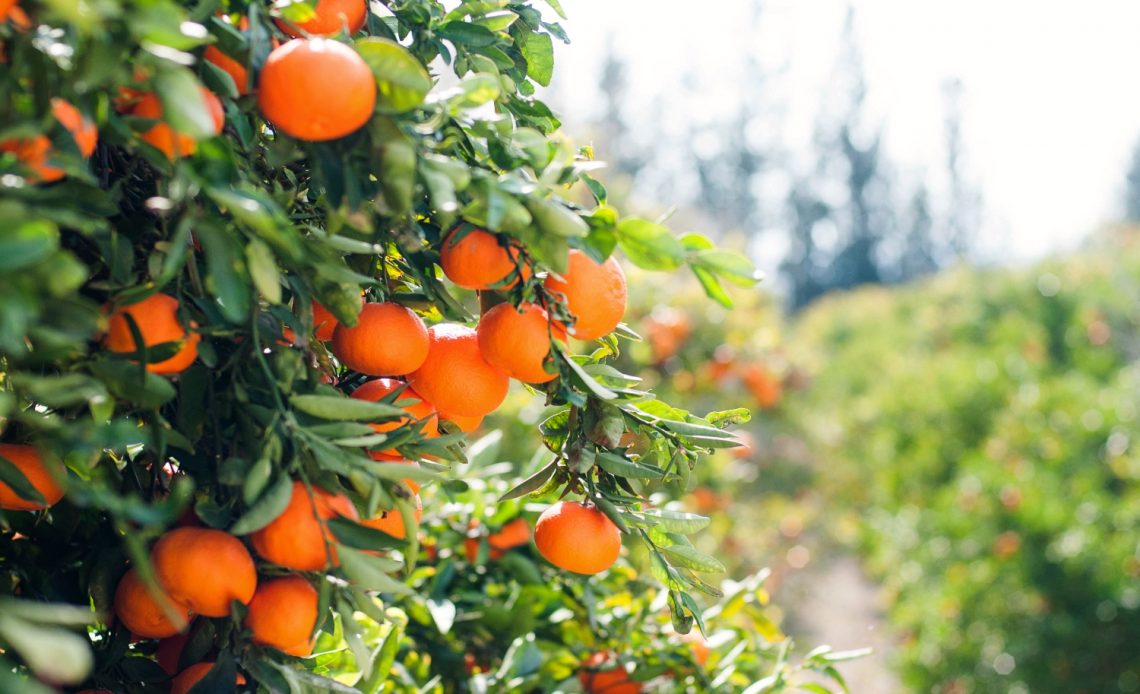

We’re here to help! Wild Yards is a completely free website that is 100% dedicated to helping you create a wildlife-friendly, sustainable yard. Read more
WildYards is reader-supported. When you buy a product through a link on our site, we may earn a comission. Every product is independently selected by our (obsessive) editors and our reviews are unbiased and objective. Read more about our mission or our privacy policy.
Looking to add a few fruit trees to your garden orchard? Great idea! There’s nothing like the taste of fresh fruit, straight off the tree.
The only downside is that it can take some fruit trees years before they begin flowering and producing.
Pawpaw trees, for instance, can take up to 7 years before they begin fruiting, and sweet cherry trees can take just as long.
If you want to enjoy fresh fruit and you want to enjoy it soon, you’ll need to plant trees that begin producing at a younger age.
But what are the fastest growing fruit trees that you can plant in your garden?
Citrus trees like Dancy mandarins and Meyer lemons begin producing fruit in as little as 2 to 3 years. Elberta peach, Gravenstein apple, and Kieffer pear trees are more traditional choices, but exotic fruits like Bue Java banana, Glenn mango, and dragon fruits grow rapidly as well.
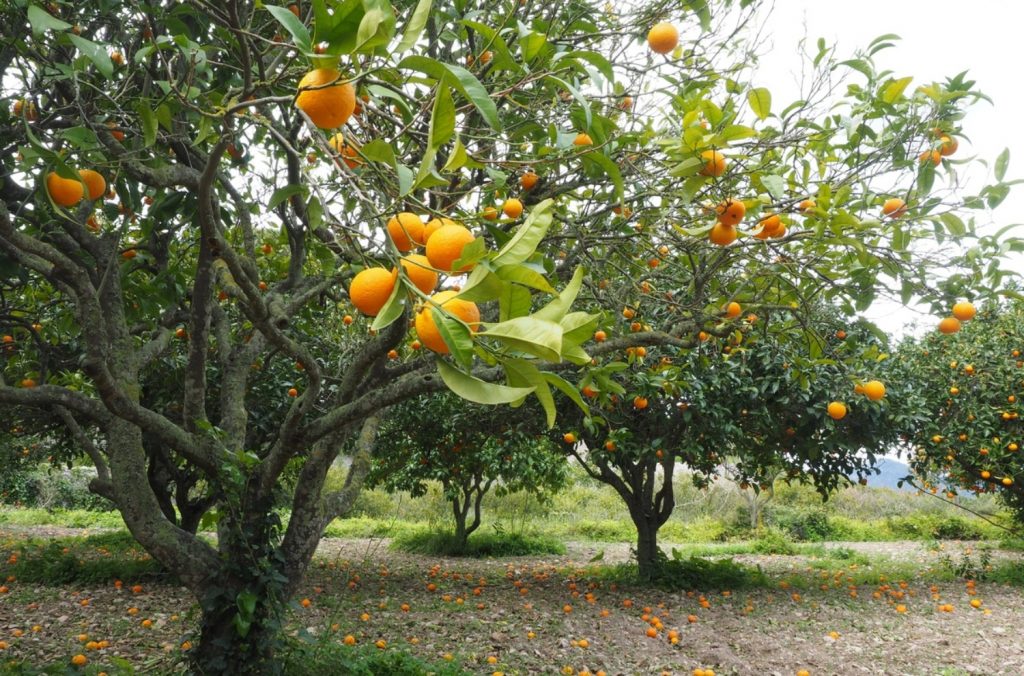
16 Fastest-Growing Fruit Trees To Plant In Your Backyard
Homegrown fruit is hard to beat, but patience is the name of the game when it comes to growing your own backyard orchard.
It takes most fruit trees several seasons before they start making fruits. And trees started from seeds tend to take longer than grafted trees.
The good news is, you can cut down on the wait time by choosing only the fastest-growing fruit tree cultivars.
Here are 16 great options that will give you loads of fruit to enjoy within just a few growing seasons.
Elberta Peach
| Scientific name | Prunus persica ‘Elberta’ |
| Growing zones | 5 through 9 |
| Light requirements | Full sun, 6 to 8 hours daily |
| Soil preference | Loamy, fertile, well-draining, pH 6.0 to 7.0 |
| Growth rate | 12” to 24” per year |
| Maximum size | 15’ to 25’ tall |
| Time it takes to produce fruit | 3 to 4 years |
| Fruiting period | July to August |
The Elberta peach is beloved for its ability to begin producing fruits within just 3 to 4 years time.
Elberta peaches are juicy and sweet, perfect for eating straight off the tree or canning and baking.
The Elberta peach tree can produce as much as 150 pounds of peaches in a single growing season. You’ll get loads of delicious fruits to enjoy and share with family, friends, and neighbors.
One thing to note about this freestone peach tree is that it is not drought-tolerant. Though the Elberta peach can survive in full sunlight, and even in high heat, it needs to be watered regularly to thrive.
Be sure to water this tree well after transplanting to help it get established. Once established, water the tree deeply once or twice a week (or more in hot weather) to keep it adequately hydrated.
For best results, water your Elberta peach tree early in the morning. This way you can ensure the tree is adequately hydrated before the hottest part of the day.
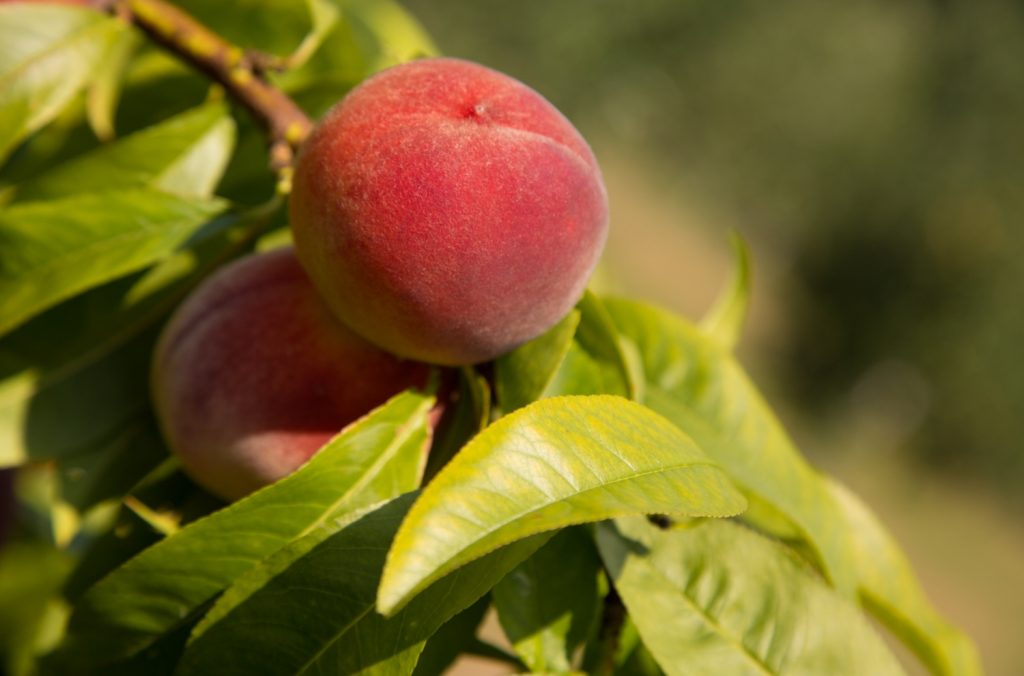
Meyer Lemon
| Scientific name | Citrus x limon ‘Meyer’ |
| Growing zones | 9 through 11 |
| Light requirements | Full to partial sunlight |
| Soil preference | Well-draining, loamy, rich in decaying organic matter, pH 6.0 |
| Growth rate | 12” to 24” per year |
| Maximum size | 6’ to 10’ tall; dwarf varieties 5’ to 7’ tall |
| Time it takes to produce fruit | 2 to 7 years |
| Fruiting season | From fall to winter. In warm climates, trees may fruit year-round |
The Meyer lemon tree produces bright yellow fruits that are as sour as you’d expect a lemon to be, but with a dose of sweetness that makes them highly palatable.
Trees that have been grown from seeds can take 5 to 7 years before they start fruiting. But trees that have been grafted typically begin producing much more quickly, in just 2 years’ time.
Unlike the Elberta peach, which prefers to receive regular waterings, Meyer lemon trees perform best when their soil is allowed to dry out completely in between deep waterings.
These trees produce more fruits when fed decaying organic materials, like compost, manure, fish emulsion, and worm castings. They also enjoy a tablespoon of Epsom salt once or twice a season.
The Meyer lemon tree cannot survive frosts. Be sure to cover the trees when temperatures dip below 35 degrees Fahrenheit, just to be safe, to help them stay warm.
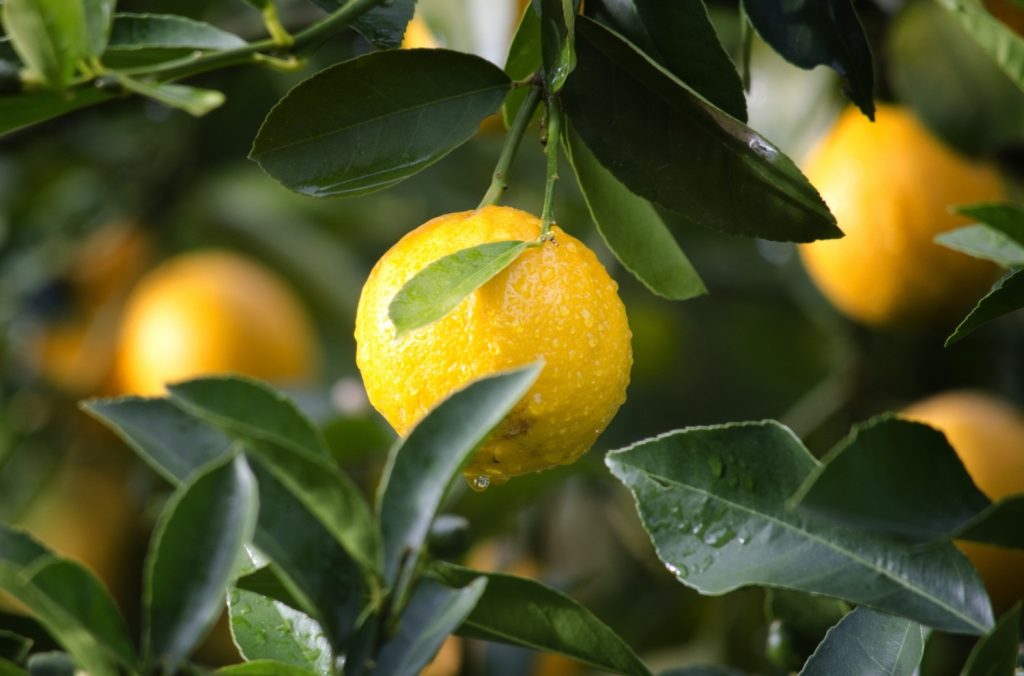
Brown Turkey Fig
| Scientific name | Ficus carica ‘Brown Turkey’ |
| Growing zones | 5 through 11 |
| Light requirements | Full to partial sunlight |
| Soil preference | Loamy, fertile, well-drained, pH 6.0 to 6.5 |
| Growth rate | 12” to 24” per year |
| Maximum size | 10’ to 30’ tall |
| Time it takes to produce fruit | 3 to 5 years |
| Fruiting season | Late spring to early summer, and late summer to early fall |
Paired with honey and goat cheese, homegrown figs are hard to resist.
The Brown Turkey fig is one of the fastest-growing varieties available. They’re also prolific producers, fruiting not once, but twice per year.
Although the Brown Turkey fig is fast growing, it will not thrive when planted in alkaline soils.
These trees also prefer warmer climates and need to be covered when the temperature drops below 10 degrees.
If you live in zone 5, 6, or 7, consider planting your Brown Turkey fig along a south or west-facing wall to trap some extra heat.
Use a thick layer of organic mulch to protect your Brown Turkey fig tree’s roots in the winter. Cedar mulch works exceptionally well for this task because it is acidic in nature, and Brown Turkey fig trees thrive in acidic substrates.
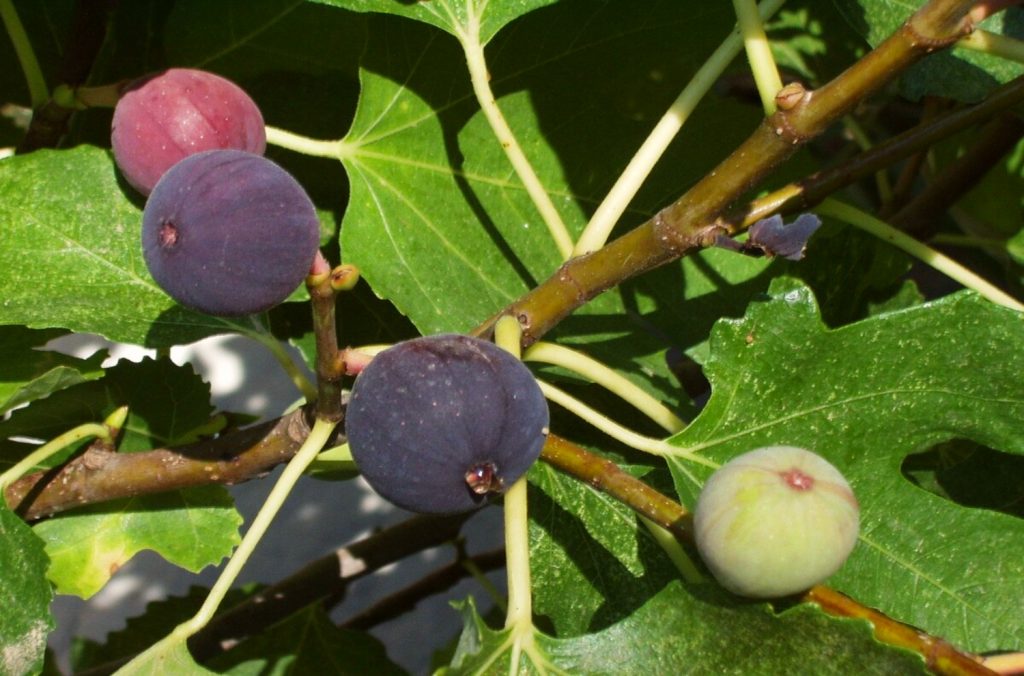
Papaya
| Scientific name | Carica papaya |
| Growing zones | 9 through 11 |
| Light requirements | Full sunlight, 6 to 8 hours a day |
| Soil preference | Sandy to loamy soil, well-draining, pH 5.5 to 7.0 |
| Growth rate | 6’ to 10’ per year |
| Maximum size | 16’ to 33’ tall |
| Time it takes to produce fruit | 4 to 11 months |
| Fruiting season | Year-round |
Who doesn’t love the tropical taste of papaya? Perfect for smoothies, salads, ice creams, and sorbets, these fruits are a feast for the tastebuds.
Regardless of variety, papaya trees are fast producers. Trees begin flowering in as little as 4 months after planting.
A single papaya tree can produce 100 to 200 pounds of fruit a year.
Papayas are some of the few fruit trees that can successfully be grown from seeds. Unfortunately, they’re also short-lived. The average lifespan of a papaya tree is just 4 years.
If you want to enjoy homegrown papayas for years to come, be sure to start new trees every season, or every other season to replace mature trees as they age out.
Papaya trees have shallow root systems and prefer loose soil that is easy to root into. These trees prefer hot, humid climates, and cannot survive cold weather or strong winds.
Gravenstein Apple
| Scientific name | Malus domestica ‘Gravenstein’ |
| Growing zones | 2 through 9 |
| Light requirements | Full sun |
| Soil preference | Loamy, well-draining, pH 6.0 to 7.0 |
| Growth rate | 12” to 24” per year |
| Maximum size | 15’ to 20’ tall |
| Time it takes to produce fruit | 2 to 5 years |
| Fruiting season | July to August |
The Gravenstein apple tree is one of the hardiest cultivars available today and can be grown in nearly every hardiness zone in the United States.
If you’re an apple fan, and you don’t want to waste time waiting for your first harvest, the Gravenstein apple tree is your best choice. Trees produce fruits in as little as 2 years.
Gravenstein apples are great for everything from snacking to cooking and baking. Fruits have a crisp, juicy texture, and a tart but sweet flavor, similar to Granny Smith and Fuji apples.
Overall, these apple trees are easy to grow and very hardy, making them an excellent choice for new fruit growers.
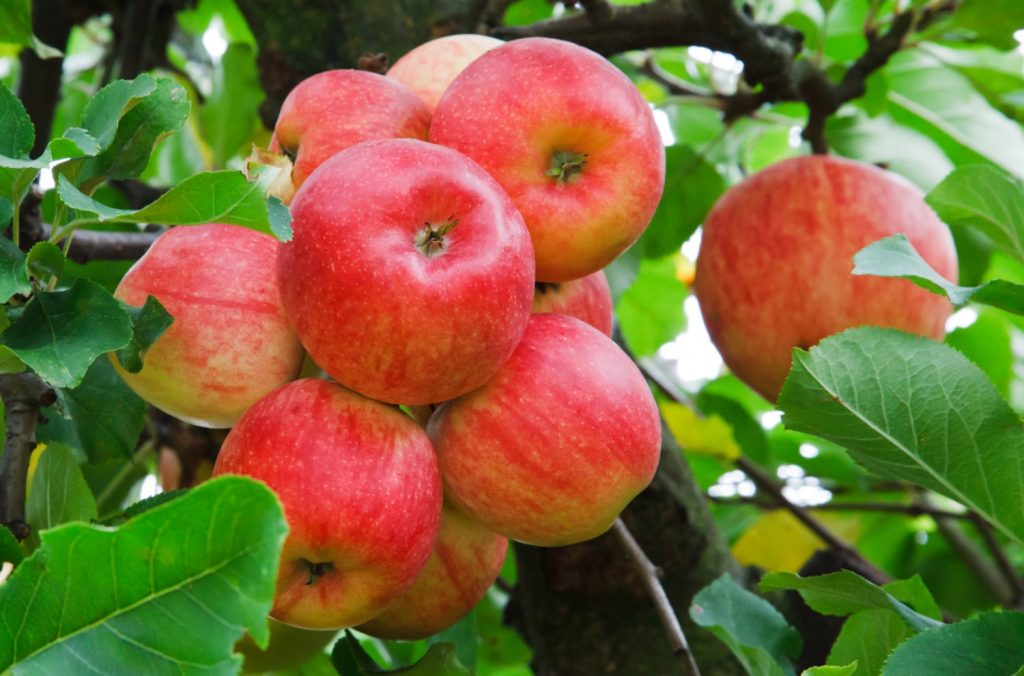
Toka Plum
| Scientific name | Prunus salicina ‘Toka’ |
| Growing zones | 3 through 8 |
| Light requirements | Full sun, 6 to 8 hours per day |
| Soil preference | Loose, loamy, well-draining, pH 6.0 to 7.0 |
| Growth rate | 8” to 12” per year |
| Maximum size | 15’ to 20’ tall |
| Time it takes to produce fruit | 2 to 4 years |
| Fruiting season | August to September |
The bright red fruits of the Toka plum tree are so sugary sweet that the cultivar earned the nickname “Bubblegum plum”.
If you love plums, don’t go without this fast-growing fruit tree. Plants thrive in full sun, and share similar growing requirements to peach trees, but are more drought-resistant once established.
The Toka plum is one of the fastest-growing plum trees on the market, and because it self-pollinates, you only need to invest in a single tree.
Trees produce scads of creamy white flowers in the early spring, adding interest to your backyard orchard and attracting bees, butterflies, and other beneficial pollinators.
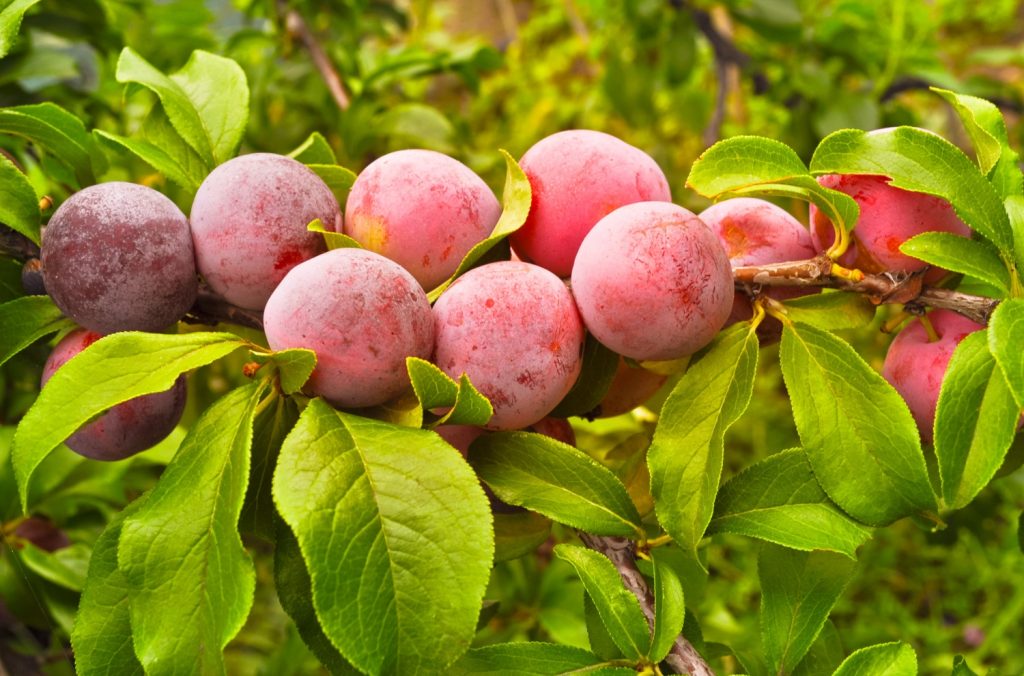
Blue Java Banana
| Scientific name | Musa acuminata x balbisiana ‘Blue Java’ |
| Growing zones | 4 through 11 |
| Light requirements | Full to partial sunlight, 6 hours a day minimum |
| Soil preference | Loose, loamy, fertile, well-draining, pH 6.0 to 7.0 |
| Growth rate | 15’ to 20’ in the first year |
| Maximum size | 15’ to 20’ tall |
| Time it takes to produce fruit | 2 to 3 years |
| Fruiting season | Year-round |
Speaking of sweet-tasting fruits, the Blue Java banana is often referred to as the ice cream banana, thanks to its sweet, creamy flesh. When blended and frozen, ice cream banana tastes just like the real thing!
This fast-growing fruit tree produces large leaves and a stout trunk. It’s a tropical addition to your backyard orchard and fits right in with your poolside landscaping.
Plants grow best from zones 8 through 11, where they’ll need protection from occasional frosts.
It is possible to grow Blue Java bananas from zones 4 through 7 as well, but they work best as a patio plant in these regions and need to be brought inside over the winter.
Banana trees mature rapidly and typically reach their maximum size a mere 9 months after planting.
White Mulberry
| Scientific name | Morus alba |
| Growing zones | 4 through 9 |
| Light requirements | Full to partial sunlight |
| Soil preference | Sandy to loamy, well-draining |
| Growth rate | 12” to 24” per year |
| Maximum size | 30’ to 80’ tall |
| Time it takes to produce fruit | 3 to 10 years |
| Fruiting season | June to August |
Although it can take the white mulberry tree up to 10 years before they begin producing fruits, plants typically start fruiting at 5 to 6 years of age.
The white mulberry tree isn’t the fastest-growing fruit tree ever. But, nevertheless, it’s on the faster end of the spectrum. Once trees begin making fruits, they can be prolific producers.
These trees can tolerate high heat and full sun, but are tolerant of partial shade, too. They’re also tolerant of periods of flooding, as long as their soil drains well.
The fruit of the white mulberry tree is juicy and sweet, ideal for homemade jellies and pies. Many songbirds are fond of snacking on these bright red and black berries, including robins, warblers, tanagers, and orioles.
Only female trees produce fruits, but they are self-fertile. For best results, purchase a white mulberry tree from a reputable nursery.
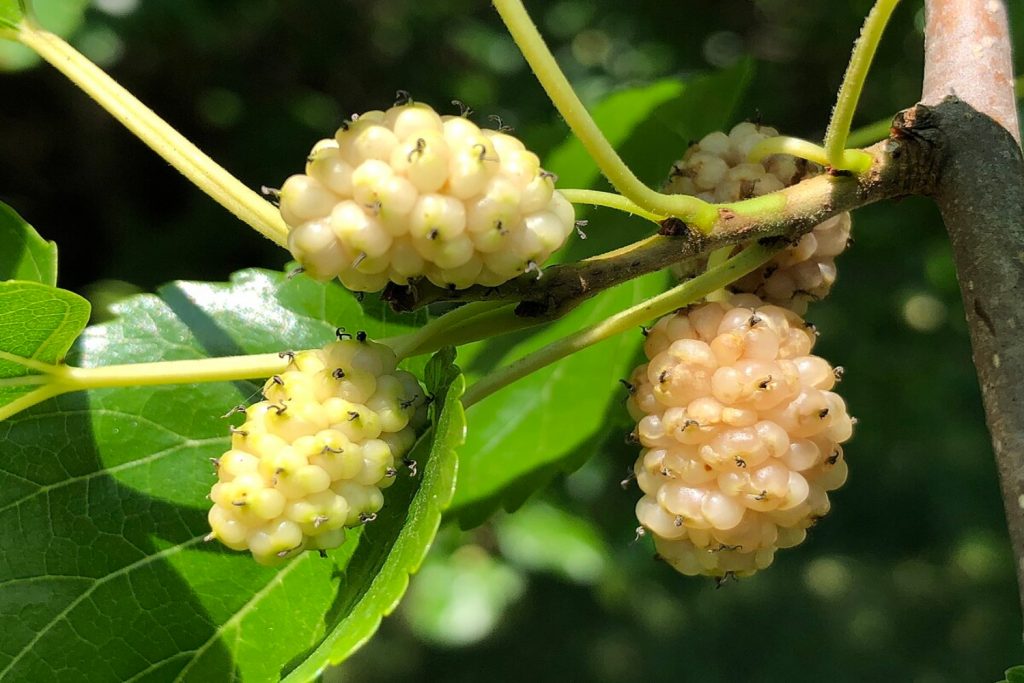
Kieffer Pear
| Scientific name | Pyrus communis ‘Kieffer’ |
| Growing zones | 4 through 9 |
| Light requirements | Full sun |
| Soil preference | Sandy to loamy, well-draining, pH 6.0 to 7.0 |
| Growth rate | 12” to 24” per year |
| Maximum size | 15’ to 30’ tall |
| Time it takes to produce fruit | 3 to 4 years |
| Fruiting season | September to October |
Sweet, crisp, and juicy, the Kieffer pear is everything a good pear ought to be. You can use these yellow-green fruits for snacking, baking, cooking, and canning — whatever your heart desires.
Although pear trees can be slow-growing, the Kieffer pear can grow up to 24” per year. Plants typically begin producing fruits at 3 to 4 years of age, especially when planted in fertile soil.
Kieffer pear trees are resilient and dependable, producing a heavy crop year after year.
Like the white mulberry, Kieffer pears are tolerant of periods of drought and flooding.
Pears should be harvested when they’re still hard. If you like to snack on pears, you can allow a few of the fruits to soften on the tree.
Kieffer pears have a long shelf life. Fruits can last several weeks when stored in a cool, dry place, and up to several months in the refrigerator.
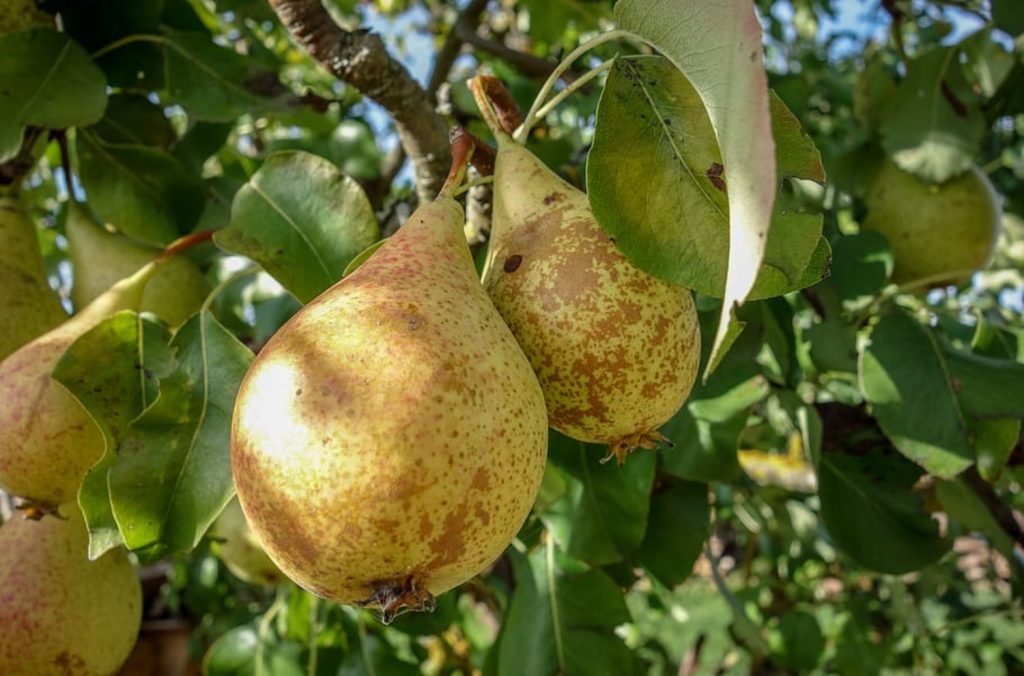
Dragon Fruit
| Scientific name | Selenicereus undatus |
| Growing zones | 9 through 11 |
| Light requirements | Bright, indirect sunlight; partial shade |
| Soil preference | Sandy to loamy, fertile, rich in decaying organic materials, well-draining, pH 6.0 to 7.0 |
| Growth rate | Up to 10’ per year |
| Maximum size | 5’ to 10’ tall |
| Time it takes to produce fruit | 1 to 2 years |
| Fruiting season | May to July |
The dragon fruit tree is one of the fastest-growing trees. Plants can grow at a rate of an inch per day.
This tree thrives in warm, humid climates. Technically a cactus, dragon fruit trees are an exotic choice for your backyard orchard.
Dragon fruit trees produce spiked magenta-colored fruits with creamy white flesh. The inside of the fruit is peppered with tiny black seeds.
These fruits are perfect for snacking, fruit salads, smoothies, and other beverages. Dragon fruits taste like a combination of kiwi, pear, and watermelon.
Be sure to grow your dragon fruit tree up a trellis. This will ensure good air circulation around the plant and support healthy fruit development.
Dragon fruit trees are easy to grow, but they can be picky about their soil.
Amend your native soil with horticultural sand to improve drainage, and be sure to include a few shovelfuls of compost and manure for added nutrition.
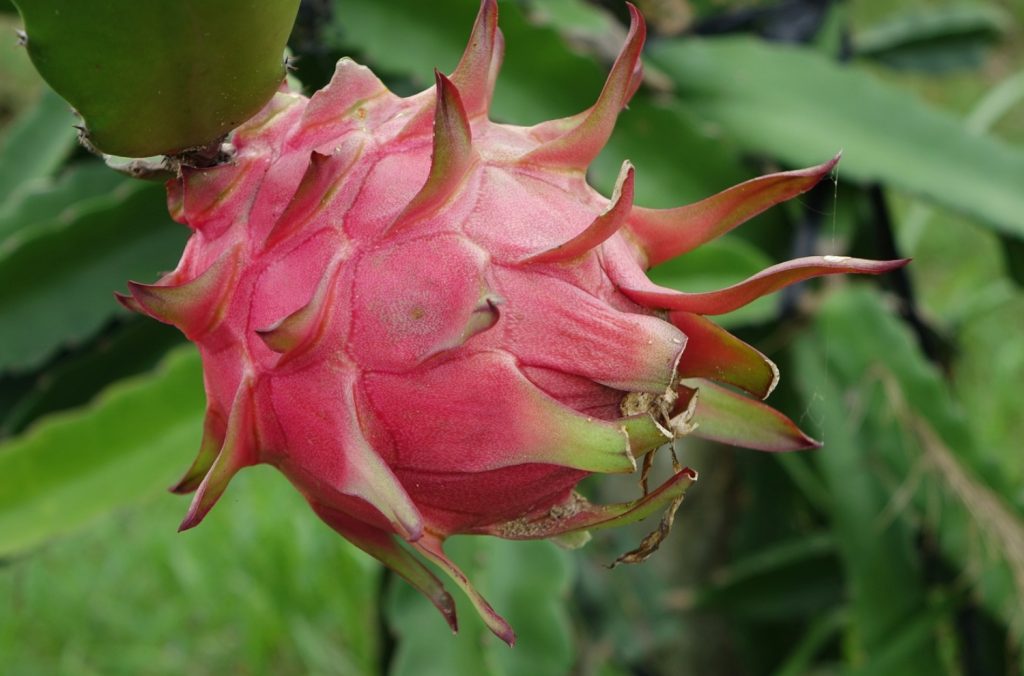
Glenn Mango
| Scientific name | Mangifera indica ‘Glenn’ |
| Growing zones | 4 through 11 |
| Light requirements | Full sun, 6 to 8 hours per day |
| Soil preference | Sandy to loamy soil, well-draining, pH 5.5 to 7.5 |
| Growth rate | 12” to 24” per year |
| Maximum size | 20’ to 30’ tall |
| Time it takes to produce fruit | 3 to 4 years |
| Fruiting season | Mid to late summer |
The bright yellow and red fruits of the Glenn mango tree are refreshingly sweet with peachy undertones.
Mangoes are often paired with kiwis for a delicious tropical taste. So consider growing kiwi vines in your garden orchard as well.
Even though the Glenn mango can be grown in virtually every growing zone across the U.S., it can only be kept outdoors from zones 8 or 9 through 11.
From zones 4 through 7, Glenn mangoes should be grown as patio trees, as they cannot survive cold temperatures.
The Glenn mango tree is a good option for warm, humid regions. In its preferred climate, the Glenn mango can grow more than 2’ per year.
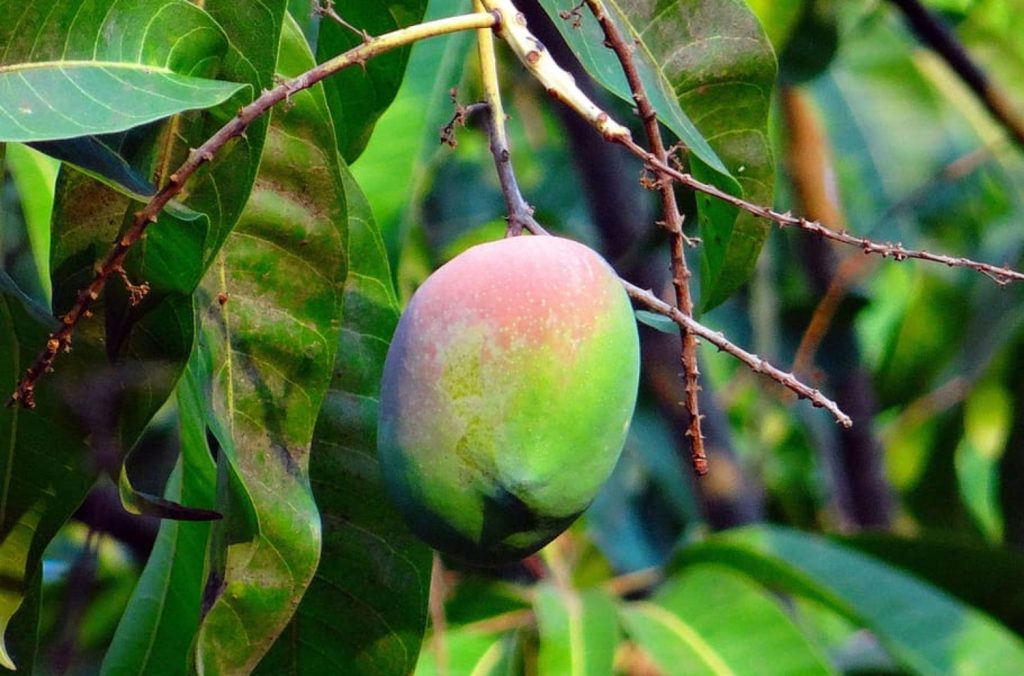
Moorpark Apricot
| Scientific name | Prunus armeniaca |
| Growing zones | 4 through 8 |
| Light requirements | Full sun, 6 hours minimum per day |
| Soil preference | Sandy to loamy, moist yet well-draining, pH 6.0 to 7.0 |
| Growth rate | 24” or more per year |
| Maximum size | 15’ to 20’ tall |
| Time it takes to produce fruit | 3 to 5 years |
| Fruiting season | July to August |
Some apricot varieties can take their sweet time, but not the Moorpark cultivar. This apricot tree begins fruiting in as little as 3 years.
Moorpark apricots are self-fertile. You only need one tree to get a harvest. But, for best results, it’s best to plant two trees. This will produce more fruits that are of a higher quality.
The Moorpark apricot grows best in moist soil and needs to be watered regularly.
If your soil tends to stay dry and if you frequently experience droughts, this is not the best fruit tree for your garden.
Because Moorpark apricots do not ripen all at once, you can enjoy sampling these vibrant orange fruits throughout mid to late summer.
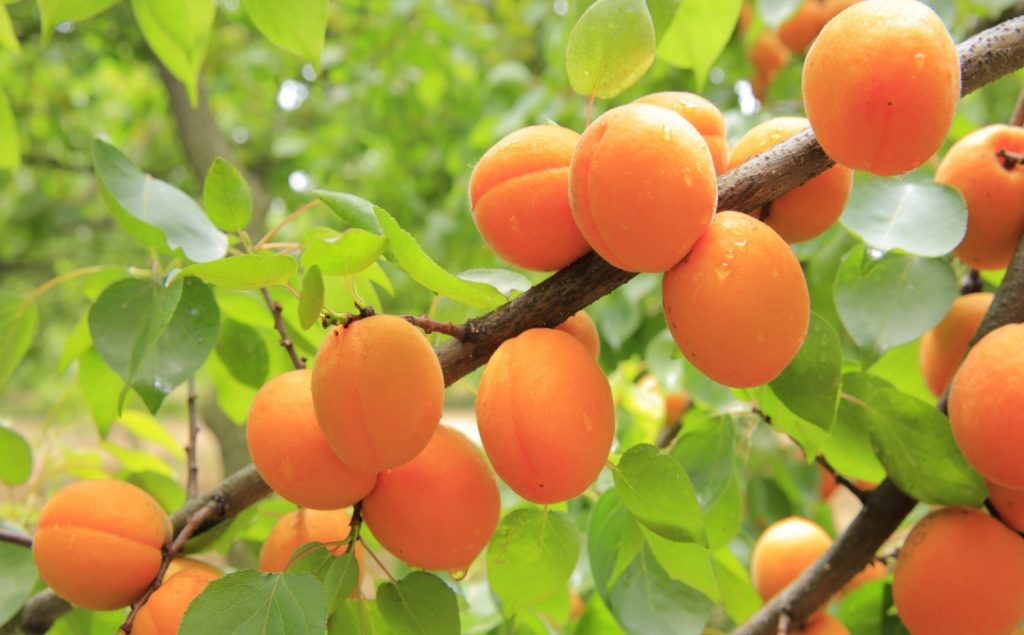
Hass Avocado
| Scientific name | Persea americana ‘Hass’ |
| Growing zones | 4 through 11 |
| Light requirements | Full sun |
| Soil preference | Sandy to loamy, moist yet well-draining, pH 6.0 to 7.0 |
| Growth rate | 12” to 24” per year |
| Maximum size | 30’ to 40’ tall |
| Time it takes to produce fruit | 3 to 13 years |
| Fruiting season | Spring to fall |
Did you know that avocados have been enjoyed for over 10,000 years in Mexico?
If you can’t get enough avocados, why not try your hand at growing some yourself? The Hass avocado is one of the fastest-growing fruit trees for warm-weather orchards and can produce 150 fruits in a single season.
Hass avocado trees can be grown from zones 4 through 11. In cooler regions, it’s kept as an indoor or patio tree.
Because the Hass avocado is cold-sensitive, it should only be grown outdoors from zones 9 through 11.
If you plant your Hass avocado in full sunlight and cover it faithfully every winter, you may be successful growing this tree in zone 8, too.
It’s certainly possible to grow your own Hass avocado tree from a seed taken from store-bought fruit.
But trees grown from seeds can take up to 13 years before they begin fruiting, whereas grafted trees typically produce at 3 to 5 years.
A grafted Hass avocado tree sourced from a reputable nursery will also yield higher-quality fruits than a tree grown from a store-bought avocado’s seed.
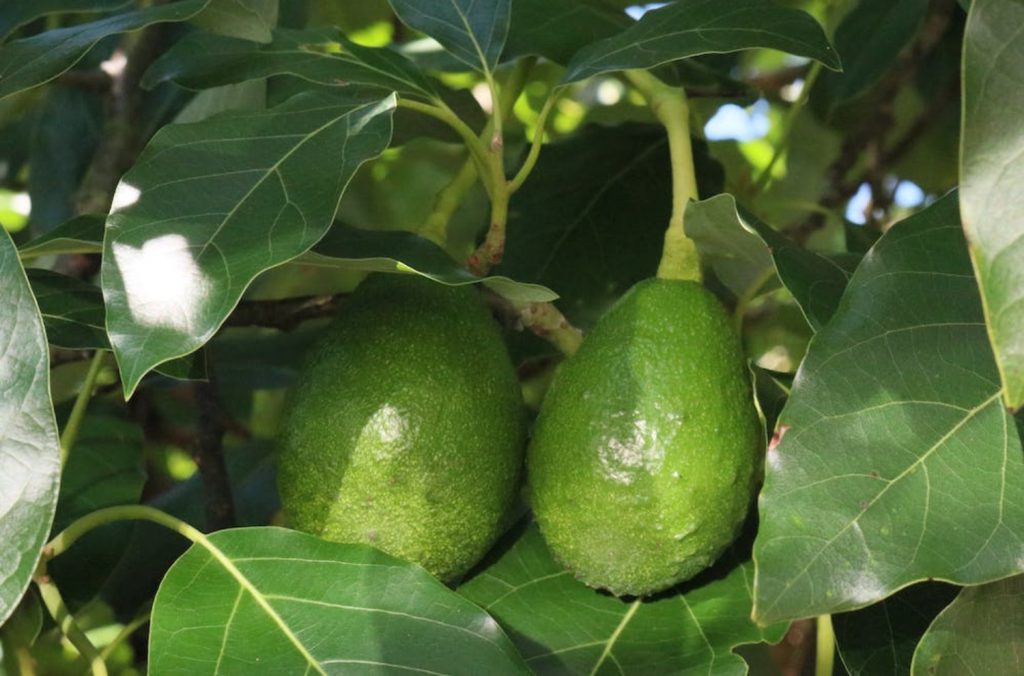
Russian Pomegranate
| Scientific name | Punica granatum |
| Growing zones | 6 through 10 |
| Light requirements | Full sun, 6 to 8 hours per day |
| Soil preference | Sandy to loamy, loose and well-draining, pH 6.0 to 7.0 |
| Growth rate | 12” to 24” per year |
| Maximum size | 8’ to 10’ |
| Time it takes to produce fruit | 2 to 4 years |
| Fruiting season | Late summer to early fall |
One of the great things about the Russian pomegranate, aside from its fast-growing nature, is that even though it can survive the hot temperatures characteristic of zone 10, it can also survive cold weather.
Russian pomegranate trees are hardy to 0 degrees.
If your growing zone only experiences mild winters, you won’t have to take any extraordinary measures to ensure your Russian pomegranate tree survives.
Plants produce stunning bright pink flowers before giving way to round red fruits.
Russian pomegranates are a delicious choice for your garden orchard and can help attract bees, butterflies, and hummingbirds to your backyard space.
Barbados Cherry
| Scientific name | Malpighia emarginata |
| Growing zones | 9 through 11 |
| Light requirements | Full to partial sunlight |
| Soil preference | Sandy to loamy, well-draining, pH 6.0 to 7.0 |
| Growth rate | 12” to 24” per year |
| Maximum size | 6’ to 12’ tall |
| Time it takes to produce fruit | 1 to 3 years |
| Fruiting season | Spring to fall |
Whether you’re looking for a fast-growing fruit tree to start your garden orchard, or an eye-catching accent tree to add to your landscaping, the Barbados cherry tree is the one for the job.
Barbados cherries are bright, shiny red, so much so that fruits almost look like they’re made of plastic. The flesh is crisp, tart, and juicy, perfect for eating fresh, but just as good when preserved.
Although these fruit trees are fast-growing, they’re a very manageable size. Plants max out at around 10’ to 12’, and can be pruned to maintain a shrub-like appearance.
Overall, the Barbados cherry tree is low-maintenance. However, it does benefit from being fertilized twice per growing season.
Be sure to feed your Barbados cherry tree with high nitrogen and high potassium fertilizers, like feather meal and potash.
Although Barbados cherries rely on phosphorus to flower and produce fruits, they don’t need huge amounts of this nutrient to stay healthy. A few pinches of bone meal applied when plants begin to flower should suffice.
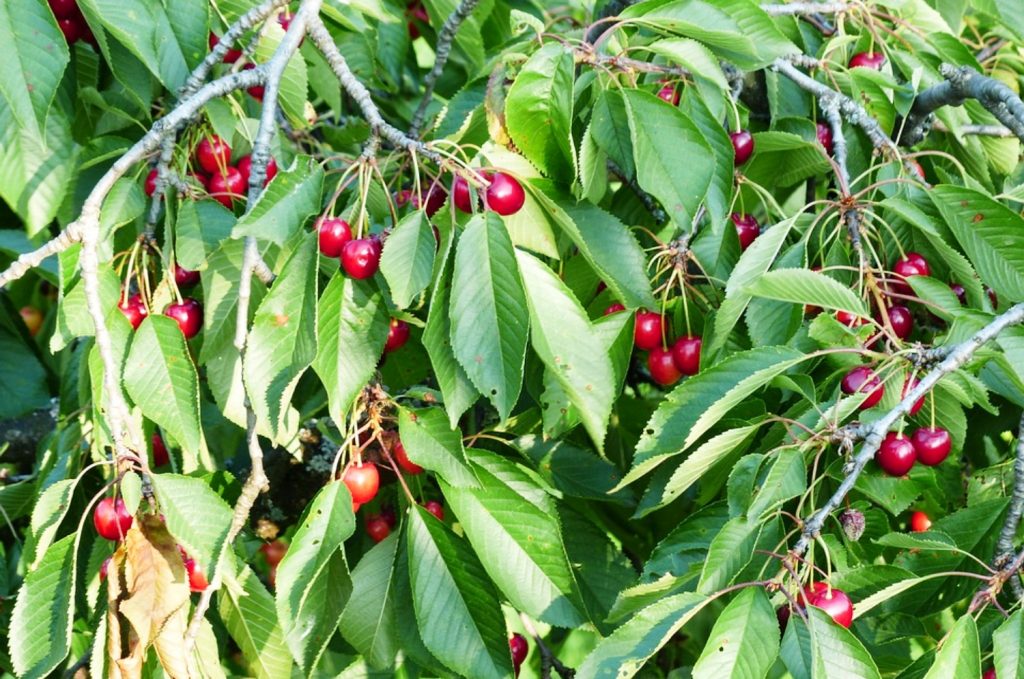
Dancy Mandarin
| Scientific name | Citrus reticulata ‘Dancy’ |
| Growing zones | 7 through 10 |
| Light requirements | Full sun |
| Soil preference | Loose, sandy to loamy, well-draining, pH 6.0 to 7.0 |
| Growth rate | 12” to 24” per year |
| Maximum size | 6’ to 15’ tall |
| Time it takes to produce fruit | 3 to 5 years |
| Fruiting season | Winter |
Often marketed as ‘Cuties’, Dancy mandarins are deliciously tangy, combining sugary sweetness with a zesty sourness that makes them a refreshing snack. Plus, they’re an excellent source of vitamin C!
Mandarin trees are usually quick to produce, and the Dancy mandarin is no different. This tree is particularly well-suited to hot, humid climates, but can be grown as a patio tree in cooler growing zones, too.
The Dancy mandarin comes in standard, dwarf, and semi-dwarf varieties, so there’s something to suit every backyard orchard, no matter how much or how little space you have to work with.
Water your Dancy mandarin tree once a week from fall to winter, and 2 to 3 times per week in spring and summer.
Be sure to fertilize your Dancy mandarin with a high-quality citrus fertilizer at the start of the growing season. This ensures your trees have all of the nutrients they need to produce a delicious, prolific harvest.
Tips for choosing the right fruit tree for your garden orchard
Be sure to choose appropriate fruit trees for your climate.
If you live in a warmer climate, choose trees that can survive the high temperatures. For gardens in cooler regions, opt for trees that are more tolerant of cold weather.
Keep size in mind, as well. Large trees like Hass avocados and white mulberries may not be a wise choice for small spaces. Choose Meyer lemon and Dancy mandarin trees, instead.
With a little careful planning and the help of these fastest-growing fruit trees, you can enjoy our very own homegrown fruit harvest every year.
